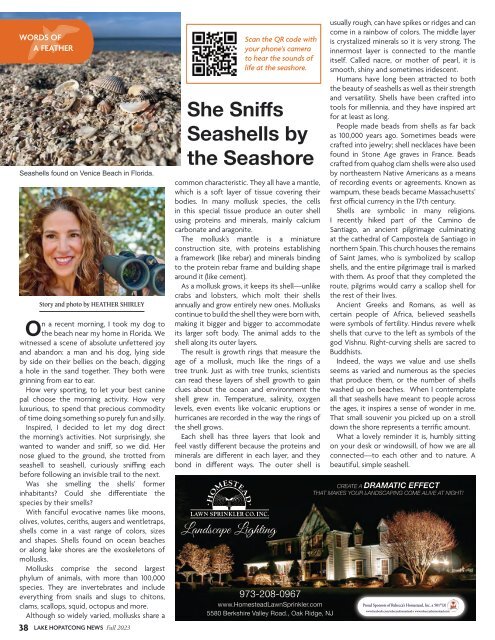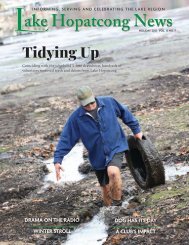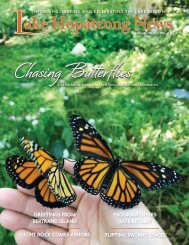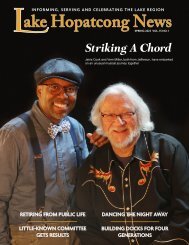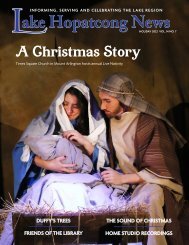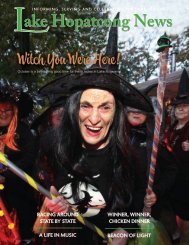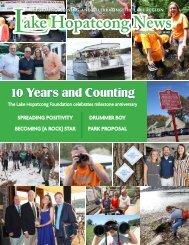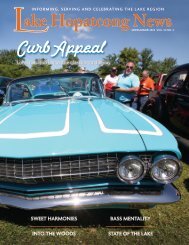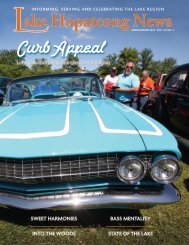2023 Fall Issue
Create successful ePaper yourself
Turn your PDF publications into a flip-book with our unique Google optimized e-Paper software.
WORDS OF<br />
A FEATHER<br />
Seashells found on Venice Beach in Florida.<br />
38<br />
Story and photo by HEATHER SHIRLEY<br />
On a recent morning, I took my dog to<br />
the beach near my home in Florida. We<br />
witnessed a scene of absolute unfettered joy<br />
and abandon: a man and his dog, lying side<br />
by side on their bellies on the beach, digging<br />
a hole in the sand together. They both were<br />
grinning from ear to ear.<br />
How very sporting, to let your best canine<br />
pal choose the morning activity. How very<br />
luxurious, to spend that precious commodity<br />
of time doing something so purely fun and silly.<br />
Inspired, I decided to let my dog direct<br />
the morning’s activities. Not surprisingly, she<br />
wanted to wander and sniff, so we did. Her<br />
nose glued to the ground, she trotted from<br />
seashell to seashell, curiously sniffing each<br />
before following an invisible trail to the next.<br />
Was she smelling the shells’ former<br />
inhabitants? Could she differentiate the<br />
species by their smells?<br />
With fanciful evocative names like moons,<br />
olives, volutes, ceriths, augers and wentletraps,<br />
shells come in a vast range of colors, sizes<br />
and shapes. Shells found on ocean beaches<br />
or along lake shores are the exoskeletons of<br />
mollusks.<br />
Mollusks comprise the second largest<br />
phylum of animals, with more than 100,000<br />
species. They are invertebrates and include<br />
everything from snails and slugs to chitons,<br />
clams, scallops, squid, octopus and more.<br />
Although so widely varied, mollusks share a<br />
LAKE HOPATCONG NEWS <strong>Fall</strong> <strong>2023</strong><br />
Scan the QR code with<br />
your phone’s camera<br />
to hear the sounds of<br />
life at the seashore.<br />
She Sniffs<br />
Seashells by<br />
the Seashore<br />
common characteristic. They all have a mantle,<br />
which is a soft layer of tissue covering their<br />
bodies. In many mollusk species, the cells<br />
in this special tissue produce an outer shell<br />
using proteins and minerals, mainly calcium<br />
carbonate and aragonite.<br />
The mollusk’s mantle is a miniature<br />
construction site, with proteins establishing<br />
a framework (like rebar) and minerals binding<br />
to the protein rebar frame and building shape<br />
around it (like cement).<br />
As a mollusk grows, it keeps its shell—unlike<br />
crabs and lobsters, which molt their shells<br />
annually and grow entirely new ones. Mollusks<br />
continue to build the shell they were born with,<br />
making it bigger and bigger to accommodate<br />
its larger soft body. The animal adds to the<br />
shell along its outer layers.<br />
The result is growth rings that measure the<br />
age of a mollusk, much like the rings of a<br />
tree trunk. Just as with tree trunks, scientists<br />
can read these layers of shell growth to gain<br />
clues about the ocean and environment the<br />
shell grew in. Temperature, salinity, oxygen<br />
levels, even events like volcanic eruptions or<br />
hurricanes are recorded in the way the rings of<br />
the shell grows.<br />
Each shell has three layers that look and<br />
feel vastly different because the proteins and<br />
minerals are different in each layer, and they<br />
bond in different ways. The outer shell is<br />
Landscape Lighting<br />
973-208-0967<br />
www.HomesteadLawnSprinkler.com<br />
5580 Berkshire Valley Road., Oak Ridge, NJ<br />
usually rough, can have spikes or ridges and can<br />
come in a rainbow of colors. The middle layer<br />
is crystalized minerals so it is very strong. The<br />
innermost layer is connected to the mantle<br />
itself. Called nacre, or mother of pearl, it is<br />
smooth, shiny and sometimes iridescent.<br />
Humans have long been attracted to both<br />
the beauty of seashells as well as their strength<br />
and versatility. Shells have been crafted into<br />
tools for millennia, and they have inspired art<br />
for at least as long.<br />
People made beads from shells as far back<br />
as 100,000 years ago. Sometimes beads were<br />
crafted into jewelry; shell necklaces have been<br />
found in Stone Age graves in France. Beads<br />
crafted from quahog clam shells were also used<br />
by northeastern Native Americans as a means<br />
of recording events or agreements. Known as<br />
wampum, these beads became Massachusetts’<br />
first official currency in the 17th century.<br />
Shells are symbolic in many religions.<br />
I recently hiked part of the Camino de<br />
Santiago, an ancient pilgrimage culminating<br />
at the cathedral of Campostela de Santiago in<br />
northern Spain. This church houses the remains<br />
of Saint James, who is symbolized by scallop<br />
shells, and the entire pilgrimage trail is marked<br />
with them. As proof that they completed the<br />
route, pilgrims would carry a scallop shell for<br />
the rest of their lives.<br />
Ancient Greeks and Romans, as well as<br />
certain people of Africa, believed seashells<br />
were symbols of fertility. Hindus revere whelk<br />
shells that curve to the left as symbols of the<br />
god Vishnu. Right-curving shells are sacred to<br />
Buddhists.<br />
Indeed, the ways we value and use shells<br />
seems as varied and numerous as the species<br />
that produce them, or the number of shells<br />
washed up on beaches. When I contemplate<br />
all that seashells have meant to people across<br />
the ages, it inspires a sense of wonder in me.<br />
That small souvenir you picked up on a stroll<br />
down the shore represents a terrific amount.<br />
What a lovely reminder it is, humbly sitting<br />
on your desk or windowsill, of how we are all<br />
connected—to each other and to nature. A<br />
beautiful, simple seashell.<br />
CREATE A DRAMATIC EFFECT<br />
LET US INSTALL FOR YOU LED LOW VOLTAGE<br />
THAT MAKES YOUR LANDSCAPING<br />
CALL US TODAY FOR<br />
COME<br />
A FREE AT<br />
ALIVE<br />
HOME ESTIMATE<br />
NIGHT!<br />
Landscape Lighting<br />
Dramatic Effect<br />
CREATE A<br />
THAT MAKES YOUR LANDSCAPING COME ALIVE AT NIGHT!<br />
5580 5580 Berkshire Berkshire Valley Valley Road Oak Ridge, New New Jersey Jersey 07438 07438<br />
973-208-0967 www.HomesteadLawnSprinkler.com<br />
Proud Sponsors of Rebecca’s Homestead, Inc. a 501 © (3)<br />
www.facebook.com/rebeccashomestead www.rebeccashomestead.com


